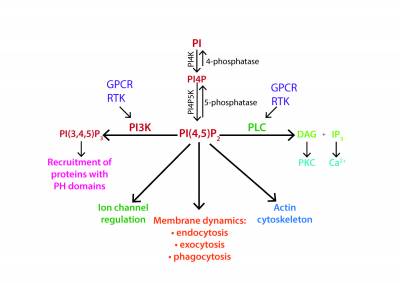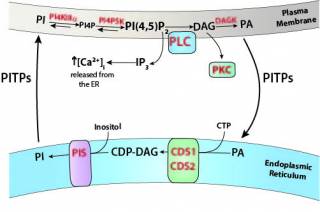Cockcroft Lab
Our research focusses on how cells regulate the synthesis of phosphoinositides and the redistribution of lipids between membrane compartments using lipid transfer proteins.
Phosphoinositides in cell signalling and membrane traffic
Phosphoinositides, in particular, phosphatidylinositol (4,5)bisphosphate (PI(4,5)P2) is a source of second messengers. Hydrolysis of PIP2 results in the production of diacylglycerol (DAG) that activates protein kinase C, and inositol (1,4,5) trisphosphate (IP3) that releases Ca2+ from intracellular stores. PI(4,5)P2 can also be phosphorylated to phosphatidylinositol(3,4,5)trisphosphate (PI(3,4,5)P3), another important second messenger. In addition to its substrate function, PI(4,5)P2, should be considered as a second messenger in its own right due to its ability to regulate exocytosis, membrane traffic and actin dynamics. PI(4,5)P2, together with other phosphoinositides are synthesised from phosphatidylinositol.
Understanding how cells regulate the synthesis of phosphatidylinositol at the endoplasmic reticulum and its distribution to the plasma membrane for signalling purposes is the main focus of my work.

Molecular and Cell Biology of Phosphatidylinositol transfer proteins
Phosphatidylinositol transfer proteins (PITPs) are lipid binding proteins that allow for compartmentalized phosphoinositide signalling in cells. PITPα, a 35 kDa soluble protein, was first identified by its ability to mediate the transfer of PI or PC between membrane compartments. A second highly related phosphatidylinositol transfer protein (PITP β) has also been described. PITPα and PITPβ are the focus of our studies.
These proteins are found in all mammalian cells and play essential roles in phosphoinositide-dependent signalling pathways. We are currently examining the molecular basis for PITP function using biochemical, molecular and cell biological techniques.
PI(4,5)P2 consumption by phospholipase C and its resynthesis: A requirement for lipid transfer from the endoplasmic reticulum by PITPs.

Shamshad Cockcroft
Professor Shamshad Cockcroft is a professor of cell physiology. Cockcroft earned a degree in Biological Chemistry at the University of Manchester in 1974 and completed her PhD in Biochemistry at the University of Birmingham in 1977. During her PhD she was introduced to the subject of inositol lipids as a potential source of second messengers by Bob Michell. She joined UCL to work with Bastien Gomperts in 1977 to work on mast cell signalling using inositol lipids.
Cockcroft's research and work investigates intracellular lipid traffic and lipids in cell signalling and membrane traffic. Cockcroft was awarded a fellowship from the Lister Institute in 1986 and established the Lipid Signalling Group at UCL. She is currently the executive Editor of BBA Cell and Molecular Biology of lipids.
Find out more about Shamshad Cockcroft
Selected Publications
- Publications Feed
RPS Widget Placeholderhttps://research-reports.ucl.ac.uk/RPSDATA.SVC/pubs/SCOCK81
 Close
Close


